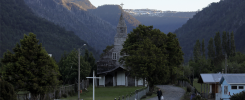
At one point there were more than 400. In 2000, sixteen of these churches were listed as World Heritage Site (UNESCO). Their value is incalculable.
They are the main attraction in the island and have accompanied chilotes for centuries. Their recognition, in 2000, as World Heritage Site (UNESCO) has made them become the small pyramids of Chile. Today, there are 86 recorded in the archipelago. At one time, there were over 400.
Today, it is possible to make the routes of the churches and it is the best way to get information about these religious relics and travel along the archipelago.

The history of these buildings date back to the Eighteenth Century, but their origin is prior to that. The first Spanish settlement was in mid-1500. Alongside these settlers, Franciscan priests arrived, who went traveling along the Big Island and the rest of islands to evangelize the population.
In 1608, with the Jesuit missions, the evangelical system had a greater development. The “go-around mission” was implemented, that is to say, priest visits were introduced; these remained in towns for a short time, so the could go then to the next town. For this purpose, chapels were established.

After the expulsion of the Jesuits in 1767, Franciscans took charge of missionary work, but the construction of temples continued in the same way. An architectural tradition called “Chilote School of Wooden Religious Architecture,” was created and kept for three centuries. The concept was the following: creek carpenters, who built chilote boats, accepted and interpreted the instructions of religious leaders on how to build churches. Religious leaders limited themselves in providing designs that came, in most cases, from churches of their hometowns.
Entirely wooden-made, churches in Chiloe represent a unique example of religious architecture in Latin America. The 16 churches that are World Heritage Sites, are located in Achao, Aldachildo, Caguach, Castro, Chelin, Chonchi, Colo, Dalcahue, Detif, Ichuac, Nercón, Quinchao, Rilan, San Juan, Tenaun, and Vilupulli.
The best way to get to know about them
If you wish to venture into the real chilote culture, you should visit “Friends of the churches of Chiloe” The foundation was established in 1993, with the help of former Bishop of Ancud, Monsignor Juan Luis Ysern. It is the best way to learn about the history of the churches, their restoration, and their cultural value for the world today.
Bladimir Corrales, who has worked in the foundation for years, says that from 1993 to 2000, the foundation focused on the collection of background data to present this information to UNESCO. “We wanted them to be declared World Heritage Site, in order to have professional help for their restoration.”

Finally, in 1999, the information was given to UNESCO. In 2000, fourteen churches were named World Heritage Site. Two were left for 2001. Afterwards, the foundation has taken a more professional direction, with architects and a methodology of intervention that has received help from the chilote community, the Council of Monuments, and UNESCO. Nowadays, have been restored (partial and completely) 14 of the 16 churches.
The initiative has a museum located in Ancud (street: Federico Errazuriz 227). There, it is possible to relive the steps taken by the foundation, learn about the restoration processes, plan your route, and deepen your knowledge of Chilote culture.

